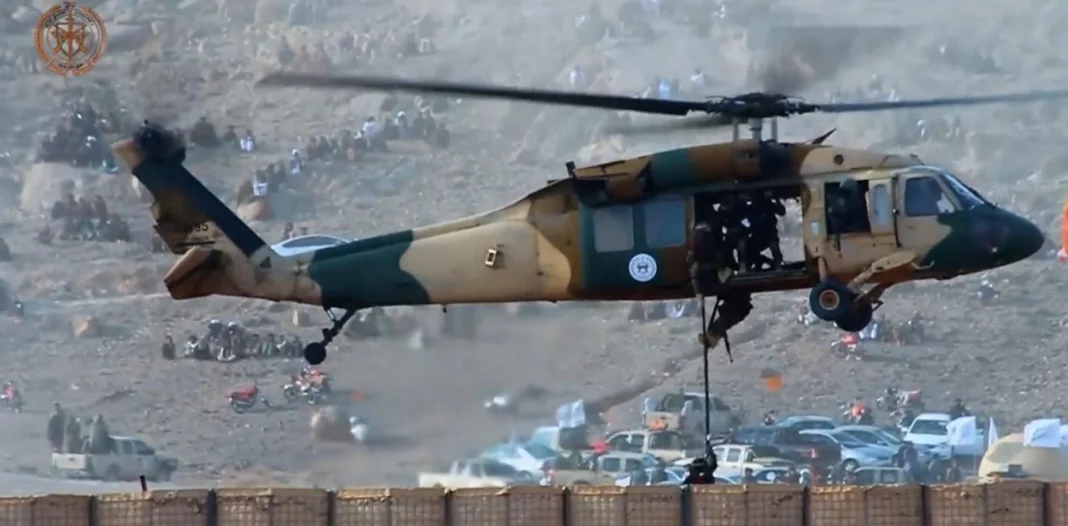When the Taliban overran the last government held positions, the bulk of the Afghan Air Force departed for Tajikistan. After the fall of Kabul, the United States likewise left an inordinate amount of military hardware. A good amount of that hardware included rotorwing assets. Attention has now turned towards whether or not the Taliban are capable of fielding offensive air assets. By utilizing geospatial intelligence sources, we are able to confidently say that the Taliban has a limited yet present ability to conduct offensive air operations against adversary entities such as ISKP or the Iranian military. However, despite current limitations, we do not rule out the possibility that the Taliban will actively attempt to build out and develop these capabilities in the next 12 months.
Key Judgment-1: It is likely that the Taliban will field offensive air assets against ISKP militants, thereby limiting the scope of the ISKP insurgency in the next 12 months.
Key Judgment-2: It is likely that the Taliban will actively develop and maintain existing commercial aviation infrastructure and future combat air capabilities in order to leverage these capabilities against Iran and Pakistan in the next 12 months.
Key Judgment-3: It is likely that the Taliban will exploit Afghanistan’s natural terrain in order to establish stronger anti-air and offensive missile capabilities in the next 12 months.
Key Judgment-1: It is likely that the Taliban will field offensive air assets against ISKP militants, thereby limiting the scope of the ISKP insurgency in the next 12 months.
a) The Taliban demonstrated an ability to operate and fly at least 8 UH-60 Black Hawk helicopters [source]. These units are stationed in Kabul [see Fig. 4].
b) At least two A-29 Super Tucanos were captured at Mazar-i-Sharif, however, we are only able to actively observe a single Mi-8 Hip transport helicopter continuously present at Mazar-i-Sharif [see Fig. 1].
c) The Taliban may have transferred these aircraft to Kabul. This is a given per the presence of other aircraft at the airport and the continuous use of Kabul and Bagram as a staging ground for demonstrations of air capabilities [source].
d) Recent satellite imagery of Kabul Airport indicates a far lower number of aircraft present compared against the months following the fall of Kabul in August of 2021 [see Fig. 4]. This may indicate that the Taliban has moved a considerable number of aircraft into storage or is actively using these air assets elsewhere in the country.
e) The Taliban is actively training units of the General Command of Police Special Units with Black Hawk helicopter based in Kabul [source].
f) Kandahar airport hosts at least 6 rotor wing aircraft and a single fixed wing C-208. Satellite imagery from February 2022 compared with imagery from March 2023 shows the aircraft in the same position [see Fig. 2, Fig. 3].
Name: Mazar-i-Sharif Airport
Location: 36°42’26.42″N, 67°12’31.05″E
Description: A large airport servicing Mazar-i-Sharif. The aircraft revetments remain empty since the Taliban takeover. A single Mi-8 helicopter is visible near a hangar on the northwest side of the airport. The airport is fully operational and the facilities and runways appear to be in good order.
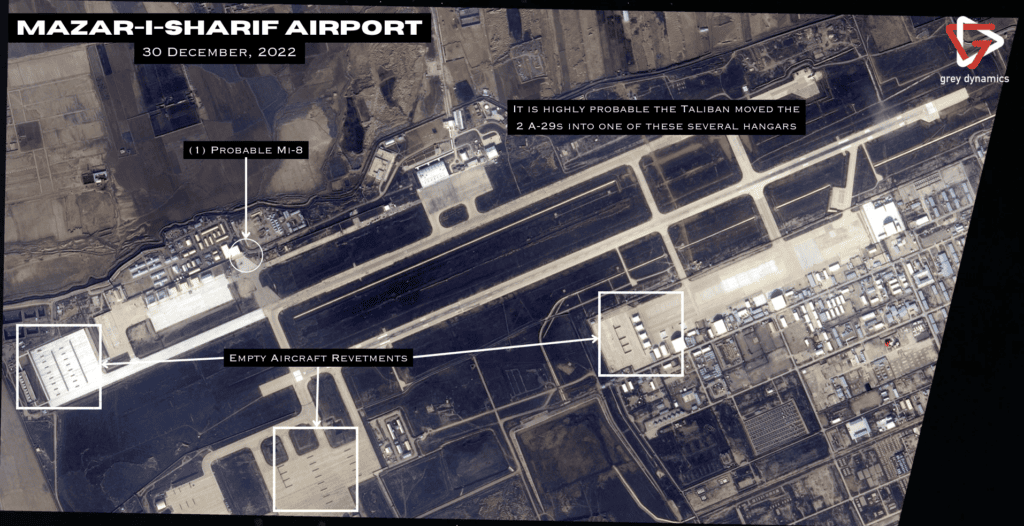
Name: Kandahar Airport
Location: 31°30’41.08″N, 65°51’45.33″E
Description: The large airport servicing the Taliban center of power, several military style aircraft are observable on the tarmac. This capture from February of 2022 shows several attack helicopters and a C-208B Caravan which appears to be placed between makeshift revetments. Given the fact that an MD 530 crashed into the river around Kandahar this year, we believe it is highly likely the smaller helicopters could very well be MD-530’s as well.
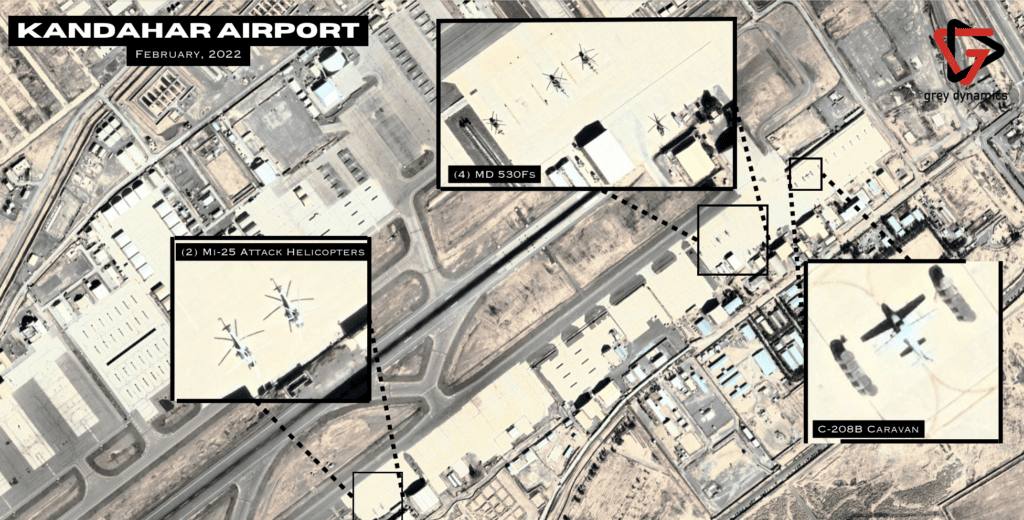
Name: Kandahar Airport
Location: 31°30’41.08″N, 65°51’45.33″E
Description: This capture of Kandahar Airport from March of this year indicates virtually no change to the position or location of the aircraft present there. We do not exclude the possibility that they have been flown and simply returned to their original positions. However, given the nature of Kandahar as the Taliban’s de facto power center, we should expect to see more functional aircraft present. This also does not preclude the possibility that any additional aircraft are being stored in hangars.
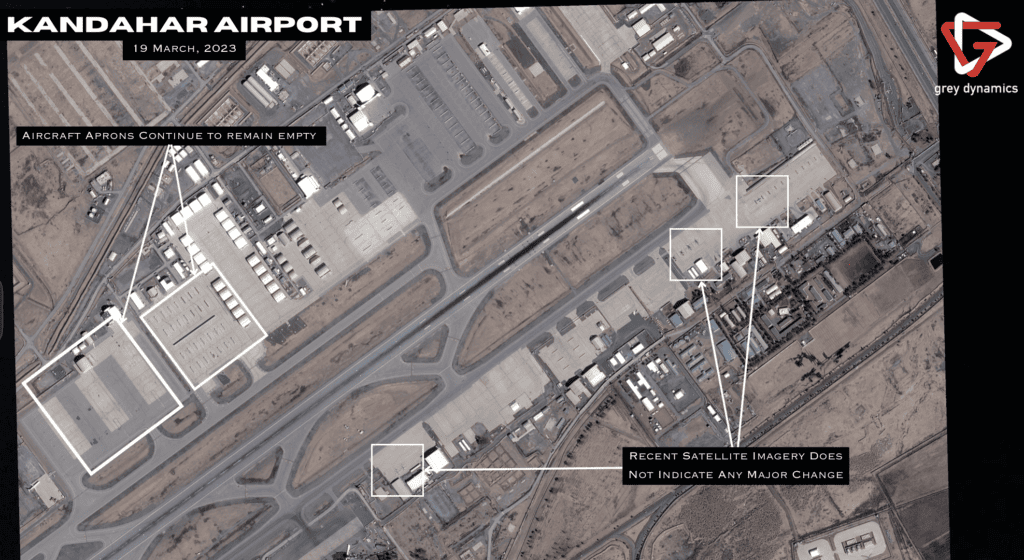
Key Judgment-2: It is likely that the Taliban will actively develop and maintain existing commercial aviation infrastructure and future combat air capabilities in order to leverage these capabilities against Iran and Pakistan in the next 12 months.
a) Despite the pilot bottleneck, the Taliban rapidly coalesced aerial combat and support equipment such as Mil Mi-24 Hind gunships and even Sikorsky UH-60 Black Hawks at Kabul Airport. Many appear to be sabotaged [see Fig. 5].
b) Despite a shortage of trained pilots in the aftermath of the Taliban’s takeover, a number of American trained pilots remain to train the Islamic Emirate Air Force [source].
c) Despite a shortage of spare parts, the large fleet of damaged American equipment serve as replacement materiel [source]. Uzbek training of airport controllers has allowed airfields like Mazar-i-Sharaf Airport to be returned to active use [source].
d) Training and active use of military air assets by the Taliban continues. Activity is detected at Kabul Airport, Mazar-i-Sharaf Airport, and Kandahar International Airport [source].
e) We were also able to identify what we believe to be 3 Aero L-39 Albatros light attack jets. These are likely remnants of the older communist regime’s Air Force [see Fig. 6].
f) Imagery of Kabul Airport after the Taliban takeover indicates a large amount of aircraft which appears to have moved by March 2023. We are unable to account for at least 2 MD 500 Defenders, 3 L-39 Albatros, 1 C-208 Cessna Caravan and a row of 3 rotorless Mi-8s [see Fig. 5].
g) There are several combat capable rotor-wing assets at Herat airport, which the Taliban has demonstrated the ability to operate and maintain over the last year and half [see Fig. 7].
Name: Kabul International Airport
Location: 34°33’57.58″N, 69°12’37.19″E
Description: Afghanistan’s largest airport plays host to the largest concentration of military grade aircraft in the country. A large amount of these aircraft have verifiably been sabotaged by departing US forces in August of 2021. This capture from March of this year still shows a large number of aircraft on the tarmac.
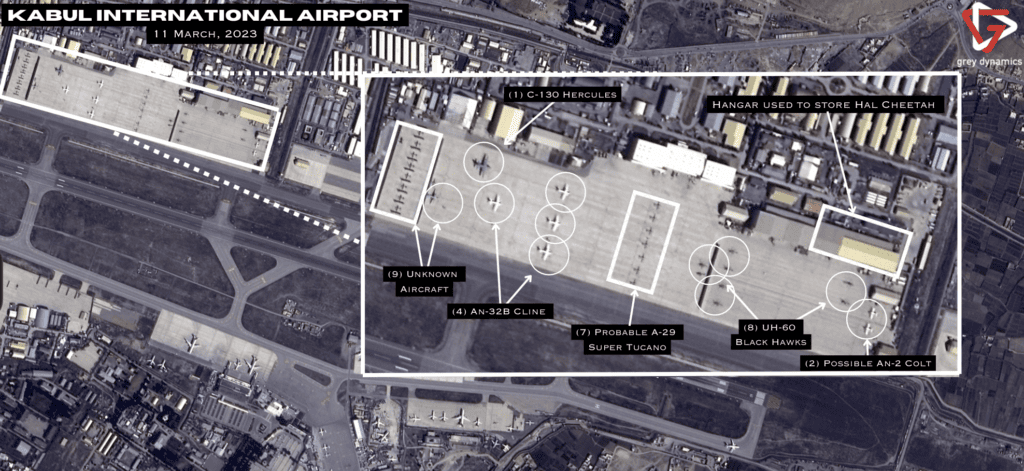
Name: Kabul International Airport
Location: 34°33’57.58″N, 69°12’37.19″E
Description: Afghanistan’s largest airport plays host to the largest concentration of military grade aircraft in the country. A large amount of these aircraft have verifiably been sabotaged by departing US forces in August of 2021. This capture from November indicates that the Taliban captured a large variety of aircraft.
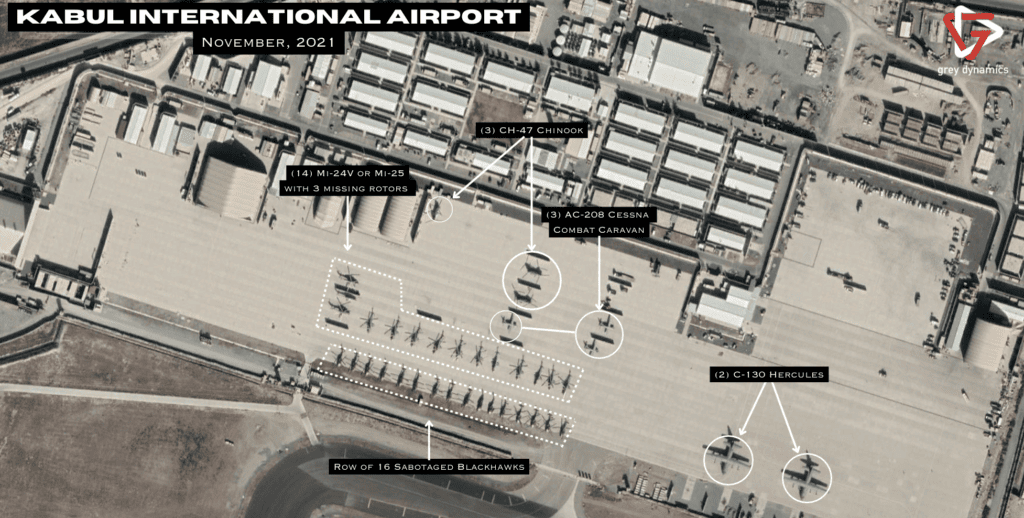
Name: Kabul International Airport
Location: 34°33’57.58″N, 69°12’37.19″E
Description: Afghanistan’s largest airport plays host to the largest concentration of military grade aircraft in the country. A large amount of these aircraft have verifiably been sabotaged by departing US forces in August of 2021. This capture from November shows the Taliban to be in possession of at least 3 L-39 light attack jets. Their state of readiness is not known.
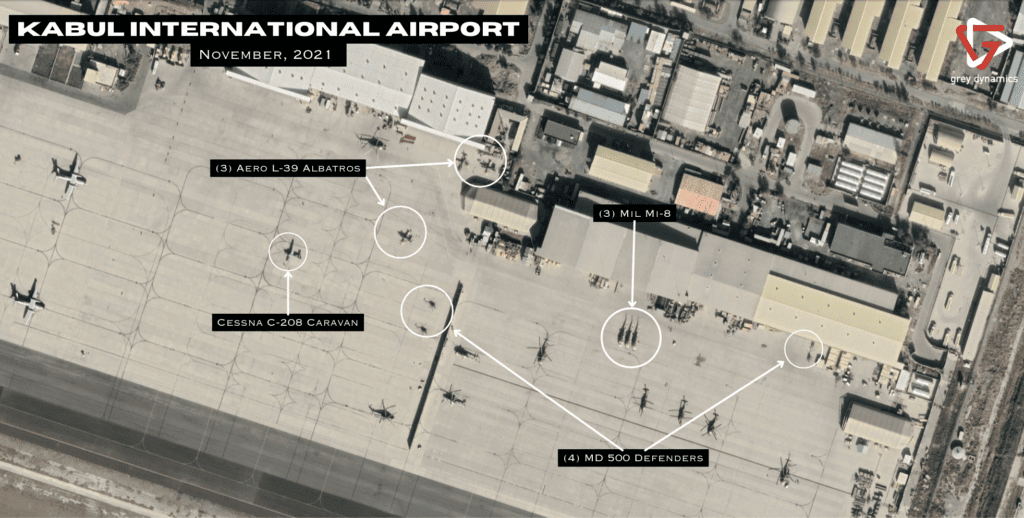
Name: Herat International Airport
Location: 34°12’58.75″N, 62°13’36.54″E
Description: A moderately sized regional airport near the border regions of Iran. A large collection of tanks sits off in a scrap yard to the left hand side of the airport facilities. A single Mi-24 attack helicopter as well as 2 Mi-17 or Mi-8 utility helicopters sit on the tarmac. A Cessna C-208 which may possibly be in a combat configuration is present.

Key Judgment-3: It is likely that the Taliban will exploit Afghanistan’s natural terrain in order to establish stronger anti-air and offensive missile capabilities in the next 12 months.
a) The Taliban is believed to possess somewhere around 4,500 units of Stinger and SA-24 Igla-S MANPADS [source].
b) A depot of Scud-B and FROG-7 missiles were uncovered by the Taliban in the Panjshir Valley in 2021 [source].
c) The Taliban may be attempting to build out a deterrence capability to be directed against Pakistan or Iran [source].
d) The Taliban also displayed its stockpile of Luna-M 9M21 missiles, Elbrus missiles and BM-27 Uragan MRLS [source].
e) Currently, the Taliban is facing serious manpower, human capital, educational and technical shortages which could complicate their operations of these missile systems [source].
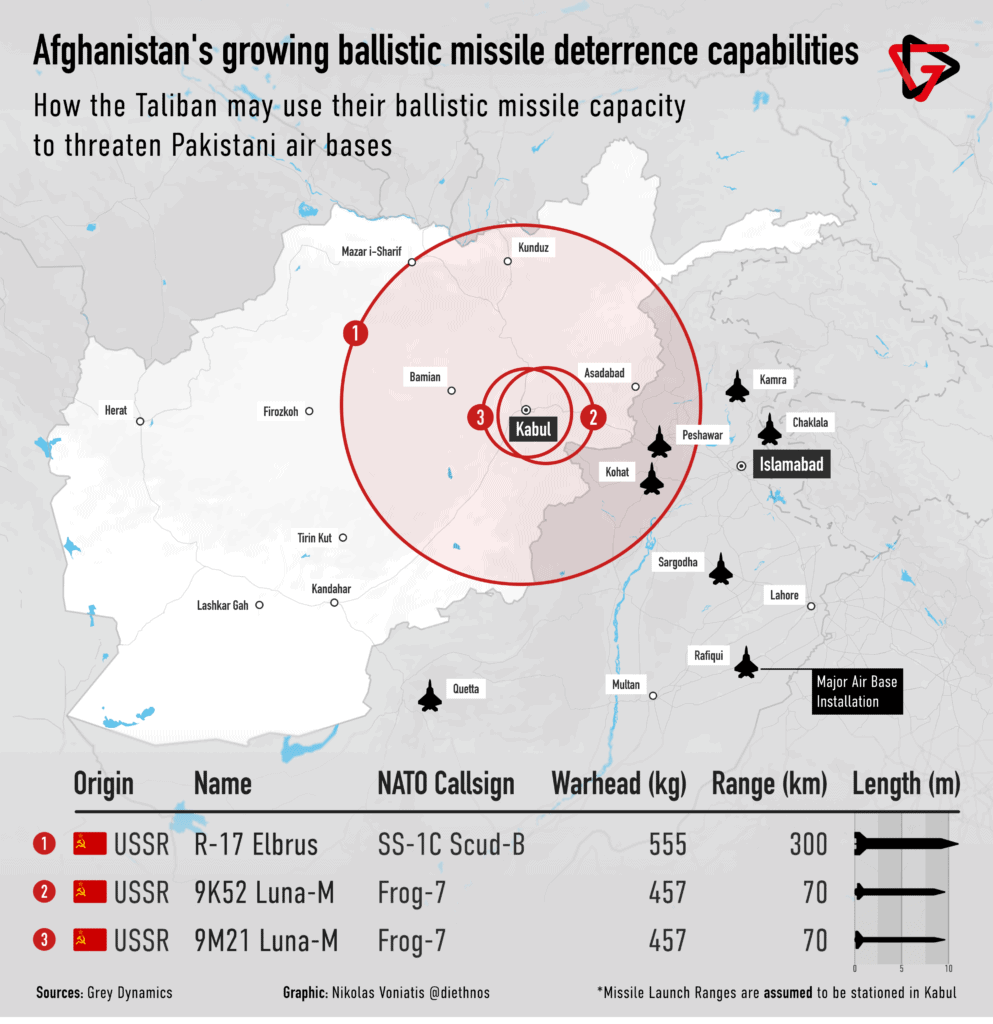
Analytical Summary
We have a strong degree of confidence in our assessment that the Taliban will direct what air assets it has against ISKP. The Taliban proved that it could fly these aircraft during demonstrations at Bagram and Kabul. Furthermore, we have seen a clear demonstration that the Taliban is actively training special forces units using UH-60 and Mi-8 and Mi-17 helicopters. These assets are rapidly becoming the cornerstone of the Taliban’s new found air mobility. For these reasons, we believe that the Taliban will strongly invest resources and energy into developing these rotor-wing assets for COIN purposes.
Repairs and Ordnance Requirements
We also have a strong level of confidence in our assessment that the Taliban will actively develop these air capabilities as a means of deterring aggressive action by Pakistan and Iran. Of particular interest is the L-39 light attack jets and A-29 Super Tucanos. The Taliban may not have any pilots rated to fly the A-29 or L-39. According to the Taliban, several pilots have returned [source]. Besides that, the difficulty in actually learning to fly these aircraft is relatively minimal. The largest issue which the Taliban faces is not in training pilots to fly relatively simple light aircraft, but the issue is in maintenance and arming the aircraft with air to ground munitions. Currently, there is no source from which the Taliban can reliably acquire these types weapons. Solving this gap between capabilities and capacity will likely be a leading priority for the Taliban going forward in the next year.
Ballistic Missile Capability
We have a lower level of confidence in our assessment that the Taliban will successfully build out a ballistic missile deterrence capability. Similar to the issues presented by arming combat aircraft, the Taliban does not have the industrial base or technical wherewithal in order to maintain a ballistic missile arsenal. A vast majority of this arsenal utilizes liquid rocket propellent, something which cannot be produced without a dedicated and competent industry. Nevertheless, underestimating the Taliban is a losing bet. They managed in 20 odd years of war with the most powerful military machine in history to acquire, deploy and create rudimentary rocket systems. The Taliban is certainly an innovative organization and necessity famously breeds innovation.

